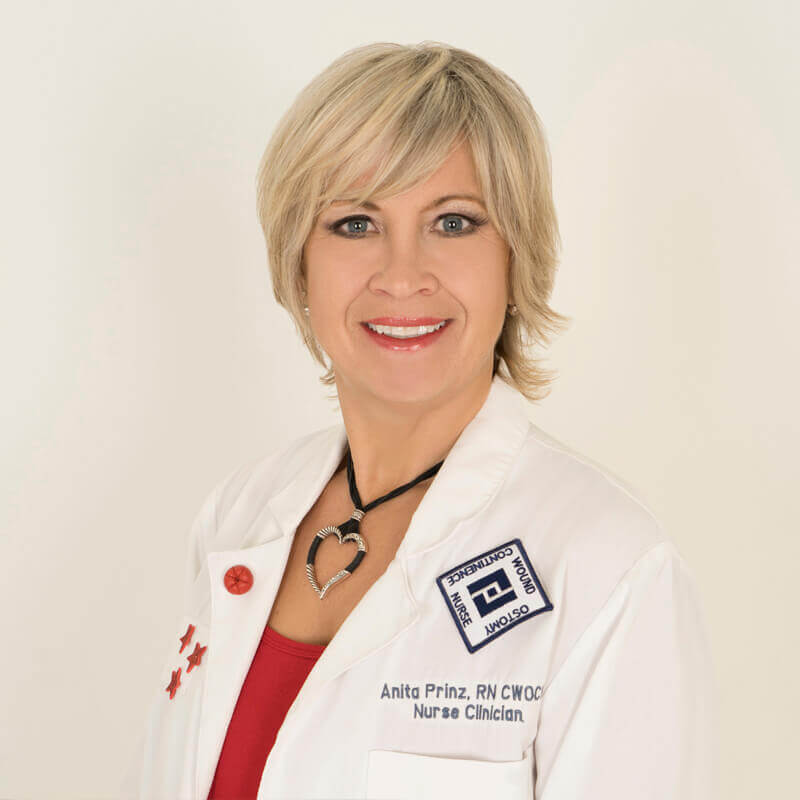A 10-year veteran of the fashion industry and Wall Street, Anita Prinz, MSN, RN, CWOCN, decided she needed a career change.
Attracted to the nursing profession, Prinz went to nursing school after working in other fields. She earned her bachelor’s degree in nursing in 1995 at Samuel Merritt University in Oakland, Calif.
Soon thereafter, she moved to New York City and worked as a visiting nurse in Manhattan while engaging in a unique mode of travel to visit her patients. “I rode my bicycle to see patients in the late 1990s,” she said.
After seeing numerous wounds in her home care patients and working with exceptional wound care nurses, Prinz said she felt called to learn more about wound care. So she pursued certification as a wound, ostomy and continence nurse.
Becoming a wound care nurse

“I viewed my wound care colleagues in home health as the goddesses of nursing,” she said. “They knew so much. I went to Texas and took a live, three-month wound care course in Houston, which consisted of two months of didactic training and one month of clinicals. I earned my WOCN in 2001.”
Prinz has a tremendous love for travel and seeing the world, so after becoming a wound care nurse, she decided to go back to New York.
Later, her curiosity about other cities led her to Texas and tenures as a wound care nurse at:
- Baylor University Medical Center in Dallas
- Veteran’s Administration in Houston
- A stint as a travel nurse
- Director of wound care with Memorial Hermann Home Health in Houston
To continue expanding her knowledge and advancing her career, Prinz chose to pursue more education. She went back to school at the University of Phoenix and earned her master’s degree in nursing in 2009.
A talented, natural teacher
Prinz joined the Wound Care Education Institute in 2019 as an instructor and was a speaker at the annual Wild On Wounds Conference in Las Vegas.
She taught sessions at WOW on colostomy irrigation and peristomal skin complications.
It brings great joy for Prinz to see her wound care students reach their “aha” moment, she said.
“When the light switches on for students and they feel they now ‘get it,’ it’s very gratifying,” Prinz said. “I have an outgoing personality, and I love sharing my knowledge and enjoy creating and giving presentations, and teaching others.”
Business owner and entrepreneur
What also is important to Prinz is sharing her expertise as the owner of her own business — AnitaNurse.com.
She works with healthcare organizations and patients as a private consultant, using her experience as a board-certified wound, ostomy and continence nurse.
Prinz said AnitaNurse.com provides a myriad wound care nurse services, such as:
- Healthcare navigation and home care safety for patients
- Staff education for healthcare organizations in pressure injury prevention and incontinence management
- Legal nurse consulting
- Expert witness and review
- Public speaking engagements
Along with training other clinicians about wound, ostomy and continence care, patient education is also important to Prinz.
She writes a regular column called “Ask Nurse Anita” for The Phoenix, the official publication of the United Ostomy Association of America, Inc., (UOAA) which serves as a resource for patients and clinicians alike.
The role of patient advocate also matters to Prinz, so much so that she is an advocacy member and speaker for the UOAA.
“It’s empowering for patients when clinicians can help them adapt and adjust to life with an ostomy,” she said. “Helping patients find ways to improve their nutrition, reduce odors and secure their ostomies are some of the many ways to help them get back to their previous lives, not feel so isolated and socialize again.”
Helping patients with wounds encompasses not only providing skilled, hands-on, evidence-based wound care practice, but also offers an awareness of the whole person, she said.
“I’m a member of the American Holistic Nurses Association and practice Healing Touch,” she said. “Helping patients incorporate mindfulness and meditation are two examples of ways to reduce their stress. When the stress hormone cortisol is high, wounds cannot heal.”
Take our Ostomy Management course today!
What do you think?

